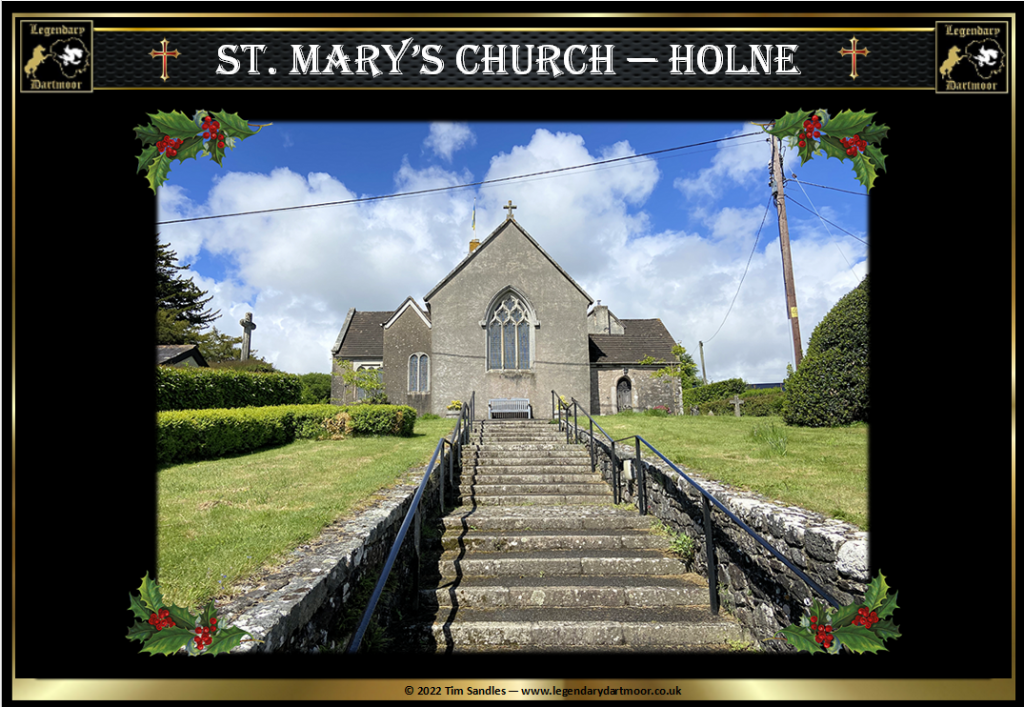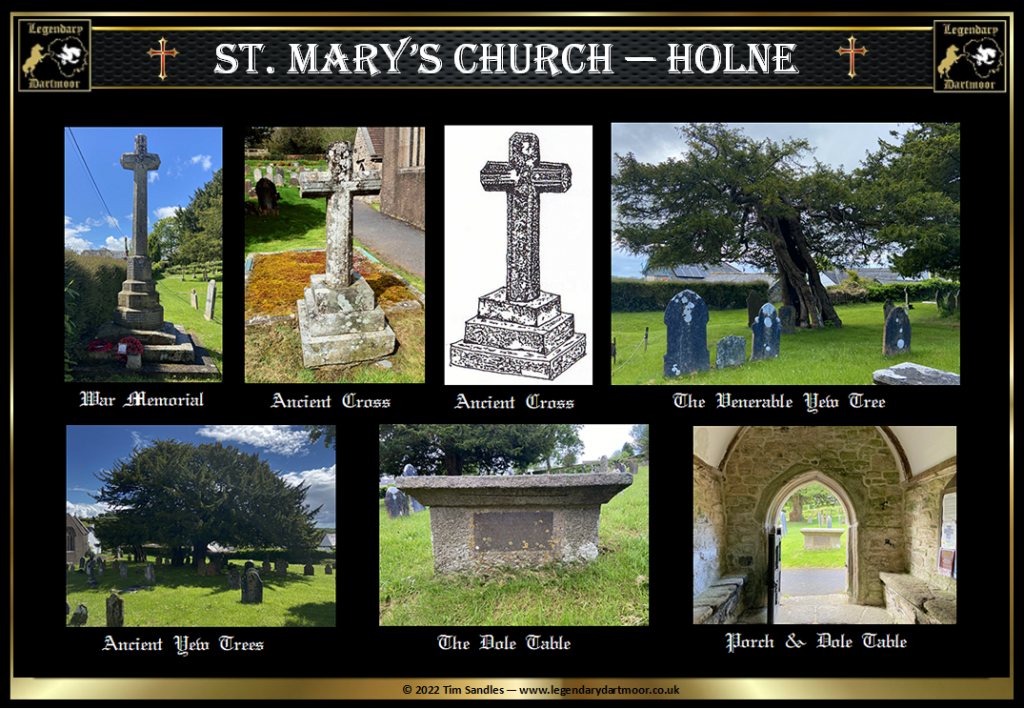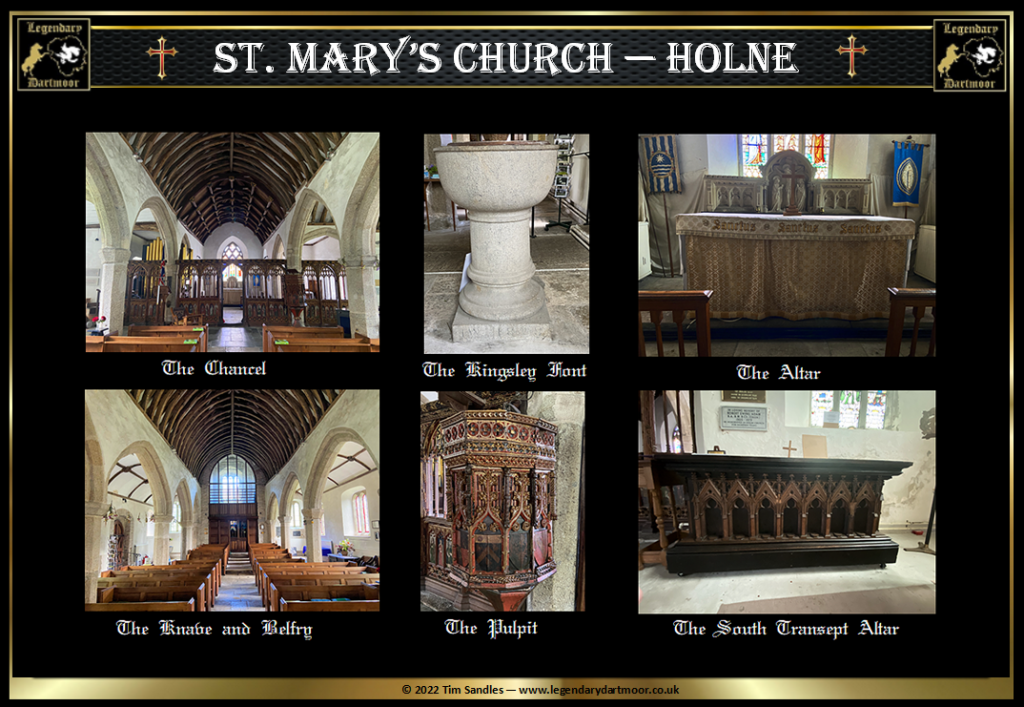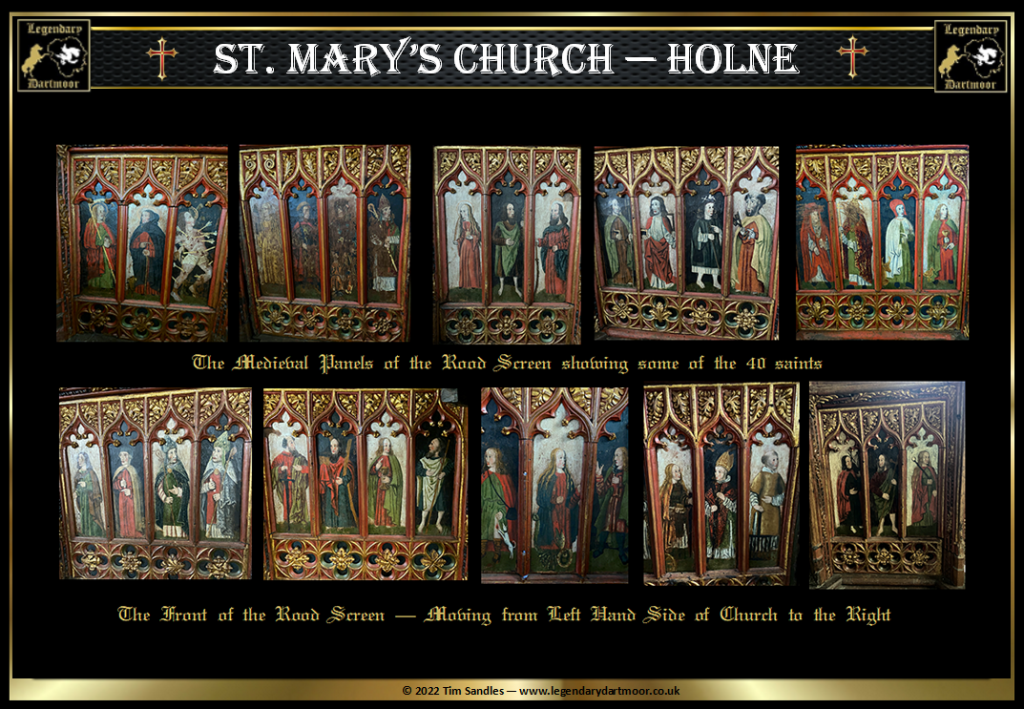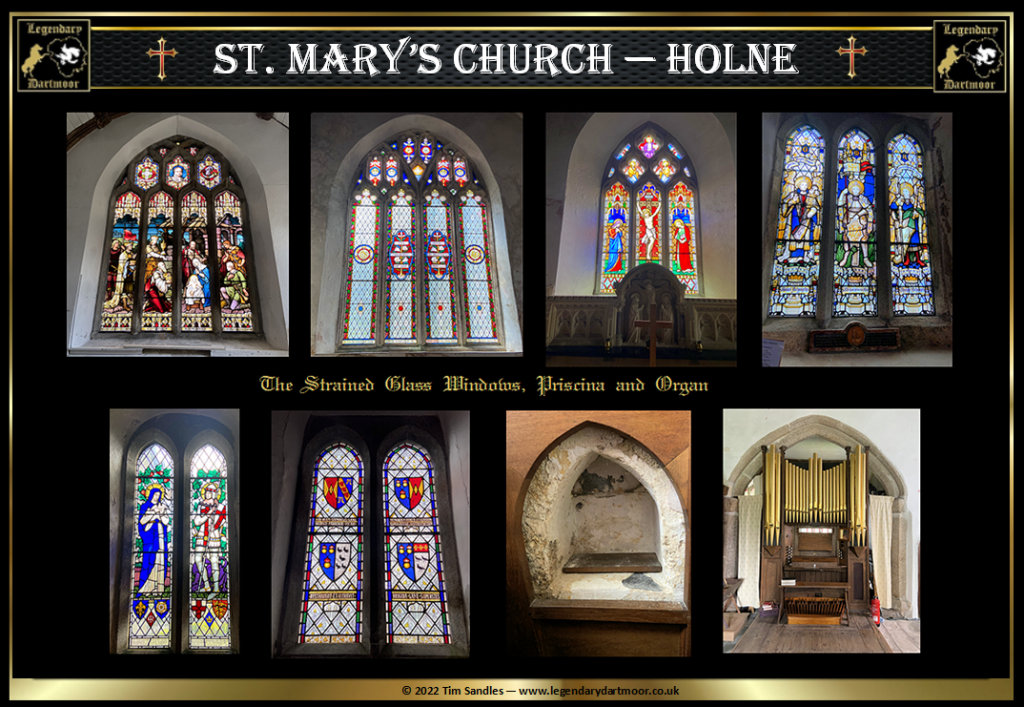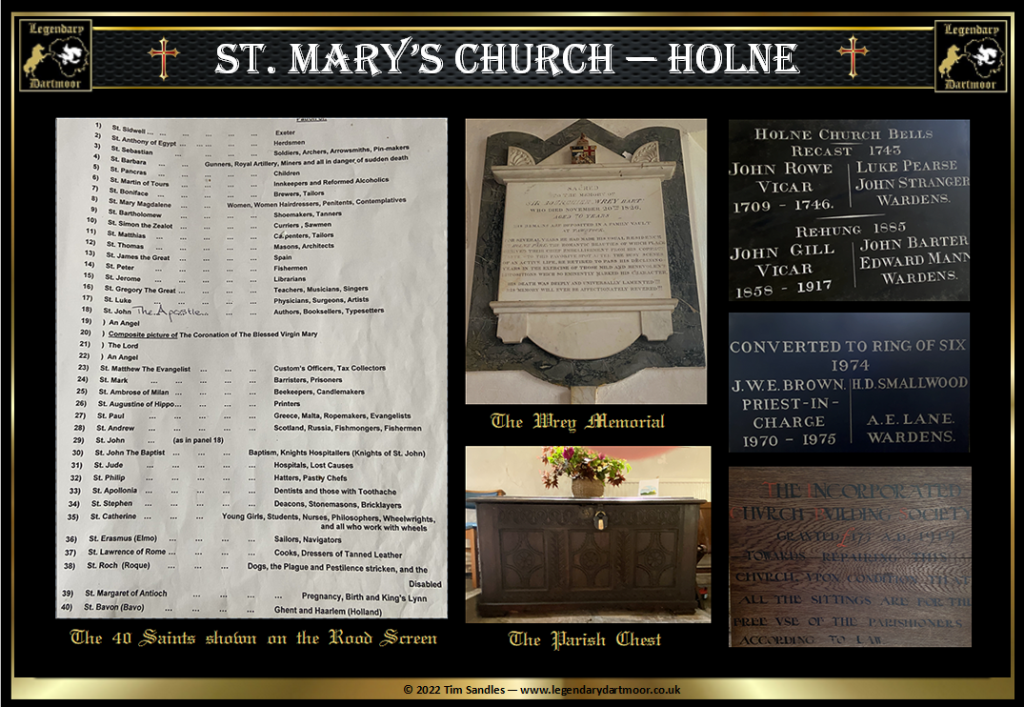
“The parish church of Holne is situated in the centre of the village, and is perfectly plain and unpretending in its structure of early English date. Dr. Oliver in his list of the Devonshire churches makes it dedicated to St. Mary. It comprises of a chancel, nave, north and south aisles and transepts, a south porch and a tower at the western end containing five bells, which though recast some few years ago, have not been rung in a peal for some time. The Archdeacon of Totnes has pronounced the cage unsafe.” – C. Worthy, November 21st, 1873.
It’s always hard to revue a church visit as people’s interests varies so much. Personally I like the more quirky aspects of the church more fascinating than the mundane everyday aspects along with the ambient atmosphere of the place. My first impressions of St. Petroc’s church in Holne was none too enthralling, the building appeared rather stark with a modern(ish) appearance. This is mainly to the sterile-looking concrete covered exterior. But, as the old saying goes, “never judge a book by its cover.” When looking at the first photograph of the church below you may wonder why sprigs of holly are mounted in each corner? The answer is simple, the first documented record of the settlement of Holne appeared in the Domesday Book of 1086 as ‘Holla‘. The word derived from the old Anglo Saxon word of Holegn which referred to a place where Ilex aquifolium (holly) grew in abundance – which it once did. The fact the name of the manor of Holla was listed in the Domesday Book gives some indication of how long the settlement of Holne has existed. The church itself dates from around the thirteenth century and is thought to have belonged to nearby Buckfast Abbey, Roger Prigge was the first known priest there in 1240. Taking into account the above comment of the church looking “modern(ish)” you can see why not to “judge a book by its cover.” The medieval dedication of the church is unknown but according to N. Orme the church was dedicated to St. Mary in 1846 – English Church Dedications, p.170.
Having mounted the eighteen plus steps of the ‘Stairway to Heaven’ you enter the churchyard which is guarded sentinel-like by the splendid War Memorial which was installed in 1921. A report of the unveiling ceremony read; “In most unpleasant weather inhabitants of Holne assembled on Saturday afternoon for the unveiling and dedication of the war memorial erected in a centre spot in the village, given for the purpose by the Hon. Mrs DAWSON. at a cost of about £65, Mr. F. Horn, Totnes. has erected a striking Gothic cross of Dartmoor granite, into the pedestal of which has been worked what has been known as “Charles Kingsley’s font” (removed from the old church, now under going extensive renovation to preserve it from total collapse), but which is really the base of the old village cross. On the cross is inscribed: “To the Glory of God and in honoured memory of the men of Holne, who gave their lives in the Great War, 1914 – 1918. Their glory shall not be blotted out.” The base bears the names of the men.- The Exeter & Plymouth Gazette, January 10th 1921. The old base in question is the second stone up from the pedestal.
Beyond the memorial sits the grave of the Revd. John Gill and his family He was a longstanding vicar to the parish and served from 1858 to 1917 when he died aged 90. At the head of his grave sits what was once an ancient cross which is thought to have originally stood at Play Cross to the south of the village. As with many of Dartmoor’s ancient crosses at some point in time it had been re-cycled for use as a gatepost as can be gleaned by the three socket holes on its south-western face. It has been muted that the cross was placed at the grave in 1884 when it was restored at the behest of a local resident by adding two new arms. As mentioned above there is speculation that the original cross base was incorporated into the war memorial.
Just behind the cross is the ‘star of the show’, that being the time-ravaged yet venerable yew tree nearest the church. Recent examinations by expert dendrologists have revealed that it is over a thousand years old and that it possibly pre-dated the church itself. It is said that this yew tree is one of just 57 veteran or significant yews that can be found in Devonshire.
There has been a great deal of speculation as to why yew trees were originally planted in such sacred places. It has been suggested that yew trees once marked pre-Christian religious sites. They have always been a symbol of the soul’s immortality due to their ability to regenerate themselves. On a practical note, they do provide shelter for any nearby buildings, graves, tombs, or people. Another common but dubious theory is that in 1483 Richard III ordered that yew trees should be generally planted in order to supply wood with which to make the famous longbows from. However, to counter-act this idea there is the thought that they were planted in churchyards to stop people cutting bow-wood. The reason for this being that the bows could be used against authority in uprisings or rebellions which was based on the theory that general superstitions of churchyards would deter such actions. The more believable theory of yew trees is that being poisonous, they were planted in churchyards to discourage people from letting their livestock graze on the hallowed ground. A rather gruesome belief from the seventeenth century was that the branches of the yew tree would absorb the gases produced by decomposing corpses and also prevent visitations by ghosts and other apparitions.
Today it is quite rare to find any Dole Tables that still exist in churchyards, but Holne church can boast an excellent example. This can be seen just opposite the front porch at St. Mary the Virgin’s church at Holne. The ancient table sits on top of one John Goswell’s chest tomb who died in 1782. The definition of the word ‘dole’ is – “a giving or distribution of food, money, or clothing to the needy.” Which is exactly what happened at a ‘Dole Table’, these were stone tables or ledges and usually located either in the churchyard or church porches. Their uses dated as far back as the medieval period and on through to the 16th/17th centuries. It was upon these stones that money or provisions were ‘doled out’ to poor parishioners or passing travellers in need of charity. It was the curate, church wardens or overseers of the poor who were responsible for the provisioning these tables. Their other purpose being that at the Table debts, tithes, and church rates were paid and also contracts settled. At some churches the Dole Table was simply a large cube of rock which also was placed in the associated churchyard.
For those who are interested in the architectural description of the church these can be found on the Historic England website –
HERE. To cover every aspect of the church’s interior would fill an entire website so here are a few of the more salient features. The first known refurbishment of Holne Church was in 1509 when the building was enlarged and the famous rood screen and pulpit were installed. Over time the church went through various stages of renovation. In 1855 a project was carried out to renew the nave and chancel roof which completely altered the structural appearance of the church. Originally the nave and chancel sat under the same roof but the reconstruction resulted in a break in the line of the waggon-head vault resulting a separation. Also at the same time the chancel roof bosses were added. Probably the most extensive renovation occurred when the Rev. Harvey Royse became the incumbent vicar the church in the 1920s. By then the whole structure of the church was in a state of bad repair. It was said that the tower badly needed repairing especially as the bell ringers often ‘took a shower’ due to the leakage, and the roof needed urgent attention along with the floor needing re-laying. The Rev. Royse decided all these problems required fixing, it was also his wish to install a new heating system, re-seat the church with oak pews, along with repairing the windows and gutters. A Dorset architect named Mr. C. E. Pointing was called in to give an estimate for the work and mush to everyone’s astonishment he put it at £4,000. So with the hope of ‘Divine Intervention’ a massive fund raising project was launched. Over a period of four years the parishioners had managed to raise £3,000. In the June of 1921 a grand fair was held at Nearby Holne Park where is was hoped the final £1,000 could be raised. Clearly the required amount was raised for in the July of 1922 the church reopened. A report in the Western Times on the 22nd of July, 1921 read, “
Attention is drawn to the re-opening of Holne Church by the Archdeacon of Totnes. The ceremony is due to take place tomorrow afternoon and is the consummation of nearly three years’ hard work to raise the £4,000 required to complete urgent repairs. When the building is re-opened it will be free of debt, though there are still improvements to be carried out when the necessary funds are raised. The fine old screen and pulpit are now in view, their protection having been removed.” In the December of 1928 the walls of the chancel were panelled with oak wood which was sculpted by Messrs. Harry Hems & Sons of Exeter. This was carried out in memory of the late Mr. H. J. Mason who lived at Ley Ridge, Holne. Other gifts to the church were a wooden oak altar table, altar rails, altar lined and a new chancel floor.
One of the church’s ‘miracles’ is the rood screen, I call it a miracle because despite Henry VIII’s attempts to purge all religious icons and the later attempts of Cromwell’s Levellers it survived. The screen is thought to have been constructed and decorated sometime between 1480 and 1500. Along the top of the screen are many fine carvings of wheat, grapes which represent the Holy Communion bread and wine, and birds. All along the wainscot are 38 panels, (see list above) each depicting a saint with two other panels on the chancel gates showing Christ and the Virgin Mary. During the Victorian era many such church screens underwent a phase of restoration which normally involved a good coat of varnish which utterly destroyed their beauty and character. Once again Divine Intervention occurred in the form of one James Hine, an architect from Plymouth. In 1876 Hine was commissioned by Holne church to produce a report on the state of the screen’s fabric. He concluded that – “Some few judicious repairs are needed to the wood-work of the grand old screen, but I would regret seeing much done to it.. Especially I would deprecate any attempt to renew the paintwork – the present effect of the original colour being in the highest degree rich and beautiful.” In 2005 thanks to a charitable bequest from a devoted parishioner called Miss Joan West the Parochial Church Council contacted Hugh Harrison who was an renown expert on rood screens. He the produced a report on the screen’s structural condition and suggested the Council employ the services of Eddie Sinclair, an expert in rood screen preservation, which they did. After carefully removing the layers of grime she then assessed the paintings some consolidation work was done and then the process of repainting was carried out. In front of the right-hand side of the rood screen is the ”goblet’ shaped pulpit is of about the same date as the screen, it is elaborately carved and divided into eight compartments by eight crocketed and finialed ogee arches. There are slender buttresses separating the arches, and on the tops are the figures of eight lions. In each compartment there is a shield of arms. Here will be found the arms of Buckfast Abbey, the arms of Lacy, and one commemorating the marriage of William Bourchier with the heiress of Hankford. A parishioner once remarked to a visitor who was carefully studying the pulpit – “Looking at our ole pulpt zir? Well, he’s nigh worn out zurely, an’ us sim’d a long time that he ort to be ripped now, an’ us ‘ave bin thinkin’ ov gatherin’ the parish vur a new un, like thicky into Ashburton; but den a large place like that ud be zure to ‘ave a better un than us, of cawse.”
The most famous son of Holne was the noted author Charles Kingsley who was born in village and baptised in the church in 1819. Being such a famous person the village folk decided there needed to be a memorial to Charles Kinsley and it was suggested a window would fit the bill. In 1891 a veritable list of patrons was drawn up which included local Bishops, Archdeacons, several Lords and the High Sherriff. By the August of 1893 the sum of £75 had been raised and in 1894 having secured the necessary funds ‘The Kingsley Window’ was installed which today it can be seen in the North Transept. The main part of the window depicts the Nativity with a portrait of Kingsley along with two coats of arms on the top. Just as one enters the church the Eye is captured by a gleaming baptismal font which today is referred to as ‘The Kingsley Font’ (see above). However, here by is a mystery because the font of today is not the one in which Kingsley was baptised. In 1828 it was noted that the original font was so dilapidated and a new one was needed so a replacement was installed. For some odd reason the old font was un- ceremonially moved by a church warden to a farm yard at Mill Leat where it served as a pig’s trough. In 1892 a former resident of Holne recognised the pig’s trough as being the old font and it was carted away to Holne Park House for safe keeping. In 1895 the font was reinstalled in the church with a new base and pedestal. In 1919 it was proposed that the old font be incorporated in what was to be the war memorial and as can be seen above this was finally accomplished in 1921. The mystery being which part of the memorial’s pedestal is the old ‘Kingsley’ font?
As can be seen from the two plaques in the photograph above the church bells have gone under several ‘changes’ (excuse the pun). In 1743 they were recast and three of them had inscriptions on them, these being – “When I begin all strike in,” – “Keep peace and good neighbourhood,” – “To the church the living call & and to the grave do summon all 1783.” The bells were then rehung in 1885. A report in the Totnes Times, on December 26th, 1885, read – “Recently the five bells of Holne Parish Church have undergone rehanging at the hands of Mr. Stokes of Woodbury, near Exeter, and the vicar having invited Mr. W. Bannister, a member of the Devonshire Guild of Ringers to examine and report on Mr. Stokes’s work. Mr. Bannister has stated, as the result of such examination, that the terms of the contract have in every way been complied with, the materials being of sufficient dimensions and of good quality.” In 1974 an addition bell was hung in the belfry thus making a peal of six bells. William Hext was the local miller in the late 1890s early 1900s and was also the Captain of the Bell Ringers for many years, right into his old age. It is said that after World War I when the bells were able to ring again he had to be steadied on the bell rope by another ringer such was his dedication.

In 1329 John de Blatcherwick was the vicar at Holne church and he managed to get suspended by Bishop Grandisson. His crime was to solemnise a marriage between John de Bampfeld and Joanna de Mohant without the necessary publication of the bands. It transpired that the bands for John de Bampfled had been read in several churches but prior to the marriage Joanna de Mohant was detained in Scotland due the the English and Scottish conflicts and so the proclamation on her behalf could not be made – the Bishop later relaxed his suspension.
In 1628 the vicar at Holne was one Richard Kaye and it was recorded that “he had the perpetual advowson of this living, and the impropriate tithes of it likewise, which together with the vicarage were worth about £100 a year, as well as a good estate, in the parish of Rattery.” All in all a lucrative number except he was dispossessed of his living to make way for a Puritan vicar called Gastick. As a result, some soldiers broke open the door to his tithe barn and helped themselves to the corn for feeding their horses. Having done so they turned their horses into the barn to clear up what corn was left. Having lost all his income it was reported that he was, “reduced to to such necessities that his wife, who was a gentlewoman of fortune was obliged to work for the subsistence of herself and four children. An ancient gentleman saith she would often be glad of a piece of bread and cheese, whereof he had given her many pieces. – The Exeter & Plymouth Gazette, November 28th, 1873.
In 1849 the church was the scene of a tragic accident when John Watts, a mason who was working on the roof somehow fell off it and after several months sadly died from his injuries.
A day of ‘Humiliation was when a day of fasting might be ordered by the church as a response to a catastrophe of some sort such as a war, a drought, etc. People were expected to repent their sins as a way of appeasing the wrath of God. All parishioners from 16 to 60 years of age would be compelled to spend the allotted day fasting and attending church services along with lengthy sermons. On the 26th of May 1854 such a day was observed at Holne. In this case the catastrophe wrought by God was the Crimean War. – “After sermons appropriate for the occasion, a collection was made for the wives and children of soldiers ordered to the East. The offertory in the morning and afternoon collections amounted to £10 0s. 10d., of which £2. 3s. 3½d. were contributed in sums of less than half-a-crown, – there were 33 sixpences and upwards of 7 shillings in pence and half-pence. I mention these facts because in so small a parish, they show how deep an interest is felt by all classes in those whose destitution at the present time have so strong claims upon us.” – The Western Courier, May 3rd, 1854. Clearly the money was destined for those needy families whose husbands, sons etc. that had gone to fight in the Crimean War.
In the October of 1886 the Rev. J. Gill was returning home from Ashburton in a gig belonging to the Hon. R. Dawson of Holne Park. On descending Lent Hill the horse took fright, started kicking and broke free from its harness. and taking the shafts with it. The poor reverend was thrown from the vehicle and as a result suffered cuts and bruises to his face and a dislocated shoulder.
Amongst the many graves in the churchyard is one belonging to a local family which has a sad tale to tell, On April the 27th. 1895 the Totnes Weekly Times reported that -“The wife of a farmer, about 60 years of age, left her home near Holne Moor gate for the village of Holne, where she transacted some business and again left after dark on Tuesday night. She did not arrive home, but no anxiety was manifested as she occasionally remained overnight in the village. About five o’clock on Wednesday a lad who was proceeding to work at Messrs. Berry’s Woollen Mills, at Buckfast, found her leaning over the railings of a dwelling house, two doors above the residence of the village constable. He called his mother and with assistance the body of the poor woman, who was quite dead, was removed to the Church House Inn. The coroner was communicated with and ordered Dr. Johnson to make a post mortem examination, though there was no suspicion of foul play. At the inquest a verdict of “death by natural causes” was returned.”
In the October of 1914 the Rev. John Gill was summoned to appear at Ashburton Petty Sessions. In his absence he was charged with assaulting a girl named Getrude Perkins, the daughter of a local farmer. The offence took place on the 4th of October just before the evening service began. As he entered the church all the congregation were upstanding, and he bade them to sit down. They all obeyed except Gertrude who remained standing. He then told a girl sitting next to her to make her sit down, all to no avail. So the good reverend administered some ‘divine retribution’ and forcibly pushed her into the seat and then attempted to remove her from his church. – found guilty and fined £1.
Being a rural church with many scattered farms and cotts meant at one time following a death the coffins had to be physically carried to the church for burial. In the History of Holne book appears the following – “When you died your coffin was carried to church by your family and friends. If it was a long way to the church it was best to have the funeral on a Saturday afternoon when men would be home from work. The official bearers wearing black gloves, carried the coffin out of the home and into the church. They carried it when they passed houses along the way. But along the lanes relief bearers would take over… The outward formalities of mourning were strictly observed, black crepe bands on the arms, black-edged handkerchiefs, black-edges writing paper…” – pp.11 – 12.
Somewhere in the churchyard is a grave with a unique epitaph which reads – “Here lies poor Ned – On his last mattress bed. – During life he was honest and free, – He knew well the chase – But has now run his race – And his name was Collins – D’ye see.” Apparently, the reason it was meant to be unique was because of the separation of the Christian and surnames.
In Eden Phillpotts’ fictional novel ‘The American Prisoner’ Holne church makes the following appearance – “Did you hear tell that I chanced to Holne Church a week ago y ‘ he asked, “No, I did not.” “My gentleman from Fox Tor Farm took his ladies there to worship. An’ I corned along same time with a vixen fox an’ two cubs to hang ’em up in the sight of the nation, so as all men might see I’d earned my money.” (1904, p38.) This may well allude to the old practice of nailing vermin in churchyards in order to receive the bounty paid on their heads.
Today Holne Church is one of the Dartmoor churches on the ‘Archangel Trail’ which consists of a 35 mile route across Dartmoor that encompasses 11 of its churches and a chapel. The trail starts from Brentor church and wends it way across the Moor and finished at Chagford church. The trail was officially launched on July 31st 2021 and is part of several pilgrim routes around Devon and is organised by the Devon Pilgrim project.
Finally, have you every visited a church picked up a guide book or postcard and then realised in this ‘cashless society’ that you have no hard currency to leave in the offertory box? It happens quite a lot to me as on this visit to Holne Church. Not wishing to ‘steal’ the guide book and to invite the ‘Wrath of God’ I had a quick read of its contents when much to my amazement I spotted on the back page one of my illustrations from the Legendary Dartmoor ‘Hutholes‘ page. There certainly was no acknowledgment as to its origin and I can’t remember being asked to use it – in lieu of payment and in the hope that God regarded it as fair exchange the guide came home with me.


 Legendary Dartmoor The many aspects past and present of Dartmoor
Legendary Dartmoor The many aspects past and present of Dartmoor

